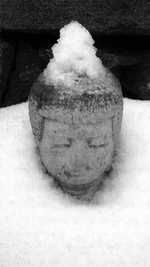This talk was given as part of a weekend program at BCBS called “Cognitive Science and the Buddhist Understanding of Mind” in January, 2005.
As I think we all know, Buddhism and cognitive science are increasingly coming into dialogue with one another these days. For this interchange to be successful, something from Buddhism or something from cognitive science (depending on which side you’re looking from) should affect the other in a way that really changes that field’s mode of operation. Perhaps Buddhism, for example, in its dialogue with cognitive science, will expand its focus in some way that it did not before. For my part, I am excited about a particular contribution Buddhism can make to the contemporary understanding of mind and cognitive science. It has to do with concepts and how we understand concepts. Today, I want to give you a sense of what the problems are, the kinds of things that have been done so far, and what a next step might be. It is a step that brings in a Buddhist analysis of concepts and applies it in a way that Buddhists themselves didn’t apply it before.
Until recently, in cognitive science and the philosophy of mind, concepts have been seen as abstract. If you look at philosophers writing about concepts up to the late nineteenth century, their paradigms for concepts were mathematical concepts and their analyses used mathematical examples. Number and certainty were the kinds of concepts they really paid attention to. But we have come to learn that the things we privilege in mathematics are not what we privilege in normal, human discourse. So we need to shift our way of thinking about concepts from abstract analyses to much more embodied analyses. Cognitive science is at a stage now where it’s more willing to consider seriously the issue of the embodiment of knowledge.
The context of our physical body systems, such as the fact that we have two arms and two legs, or that we have eyes in the front and ears on the side of our heads, may seem incidental to the way concepts are structured, but they are actually pretty important to what concepts are about.
Theory of Concepts
Let me start with the difference between an abstract theory of concepts and a metaphorical theory. An abstract theory of concepts wants to understand two things: “What is the definition of a concept?” and “How is this definition actually true of things in the world?” Let’s take as an example this cup sitting before me on the table. We want to know not only what the definition of a cup might be but how the concept of cup so defined actually “maps” to the cup we see in the world or to all the things we call cups. This turns out to be one of those classic starting points everyone thought was going to be easy, but which turned out to be very hard indeed.
It’s like the story of the professor at MIT who, in the early years of artificial intelligence research (the nineteen sixties), assigned an undergraduate computing student what he thought would be a simple summer project: build a vision system that recognizes objects in the world. It turns out that is a very hard thing to do. Now, more than 40 years and an entire computer science later, not only do we still not have a vision system that recognizes even faces, we don’t even know how our mind does that. So the hubris of the early artificial intelligence researchers is kind of laughable now, but that’s the way the field moves. There are many such painful and unexpected obstacles.
One impediment to our understanding of concepts has been a tendency to idealize both concepts and reasoning as logical and as going in certain analytical paths. But when you pay attention to the phenomenology of concepts, which is to say, how you actually use them, they turn out to be very metaphorical. Even in science, for example, when we build atomic models, we conceptualize electrons as hard spheres rotating around other hard spheres which represent the protons and the neutrons. But, of course, that’s not the way those things are. We know through quantum mechanics that they are just not localizable.
 Yet this metaphorical projection of what we know is the only kind of knowledge we have, so it’s what we use to understand our world and to transcend its own limitations. The real issue here is that we have this capacity to conceptualize, and that it is actually quite useful. It’s based on spatial and temporal ways of being in this world, and those simple ways are what we transcend and generalize in order to talk about many more complex topics. These simple concepts of space and time that we start out with, I think, are valid concepts, and as a tool for understanding we map them, metaphorically, onto more difficult things.
Yet this metaphorical projection of what we know is the only kind of knowledge we have, so it’s what we use to understand our world and to transcend its own limitations. The real issue here is that we have this capacity to conceptualize, and that it is actually quite useful. It’s based on spatial and temporal ways of being in this world, and those simple ways are what we transcend and generalize in order to talk about many more complex topics. These simple concepts of space and time that we start out with, I think, are valid concepts, and as a tool for understanding we map them, metaphorically, onto more difficult things.
Embodied Cognition
There is a whole field of “embodied cognition” these days, based on the work of people like Lakoff, Talmy and Johnson. It says we have basic concepts that pertain to the physical world, things like force, space, and time, which we use and generalize in order to speak about everything else. We use so many metaphors: “Time is like a river,” or “He’s the head of the government.” We can also look at more social or abstract phenomena.
I might say of a particularly aggressive salesman, “He pushed me into buying the radio.” Here I am taking the term “push,” which has a primary meaning that is physical, and am metaphorically mapping it to something much more abstract in the psychological realm. “Pushing” here doesn’t mean physical interchange—there may not have been any contact between these two people—but somehow the psychological meaning or social relationship is conceptualized in the same way as physical relationships.
It works the other way too. In poetry, for example, we often use nonphysical language to talk about physical things; we anthropomorphize or agent-ise entities in the world. We might talk about the beauty or the lightness of the sunshine, qualities that from a purely physical perspective are not there. But even then there is something we learn about the physical world when we take this less physical cognitive language and map it onto the world.
I think science would not work very well if the only language we had to talk about the physical word was the immediately concrete, push-and-pull kind of language, because we now know that’s not the way physics works. If the only language we could use to talk about planets and stars and atoms involved things pushing and pulling each other, then Newtonian mechanics wouldn’t have happened, let alone Einstein and quantum mechanics and all of these other wonderful things that we know about our strange universe.
The ability to metaphorically project meaning from one sphere of experience onto another is a very powerful tool that we have, which is why metaphor is so crucial. If it were merely a weak tool allowing us to make simple analogies but did not give us a real purchase on things we find important, it would not matter so much. But it has a very strong functional use. Somewhere underneath these physics-like concepts is a structure that allows us to go back and forth from the concrete to the abstract. And that, to me, is the important structure that we need to nail down, both as cognitive scientists and by using Buddhist philosophy, because I think that in some sense Buddhist philosophy captures what is at the heart of the structure of concepts.
What Is a Cup?
As cognitive science has moved from mathematically symbolic to an embodied metaphorical approach to concepts, we still don’t understand the basic problem that metaphors are solving in some way. It is essentially a mapping problem. Where is it that concepts get the structure allowing them to map between more abstract things and less abstract things? We can even start by asking something much more basic: how is it that concepts are able to refer to the world at all? How is it that when I say “cup,” I mean cup? The utterance “cup” is just a sound. How is it that a sound ever gets to a thing? Experientially a sound has an auditory dimension, and maybe it has a meaning dimension, but an object “cup” doesn’t have any of these. This cup before me is green; it has a handle; it has shape; it has sides; it has location. The word “cup” doesn’t have any of these. So how is it that something with geometric specificity gets labeled by something which has absolutely no geometric capacity at all?
The same kind of problem exists with the myria d abstract concepts which make up our world of psychology and social relationships. So much of our conceptual world has no shape or size or any physical structure, but somehow we are able to use physical language metaphorically to great effect.
d abstract concepts which make up our world of psychology and social relationships. So much of our conceptual world has no shape or size or any physical structure, but somehow we are able to use physical language metaphorically to great effect.
The deep question has to do with understanding the underlying structures allowing us to take these very different kinds of things and put them together. I think this capacity lies at the very heart of cognition. The chief factor of our intelligence has to do with taking things that are different from each other and putting them together. For example, the auditory system receives an input which is different from a visual system. And yet when we perceive the world we map it into this coherent whole with both auditory and visual characteristics. This is the binding problem. How is it that an object, when we see it, has color, shape, size, all of them in the same location, even though the inputs into the system are very different things? Color is not like shape at all.
Another big problem with concepts is that they turn out to be hard to define. What, for example, really is a “cup?” Is it just something that contains other things? No, because what is contained? Fluids? Yes, but not exclusively. Is a cup something that has a handle? Not necessarily. If I took the handle off this cup, you would still say it’s a cup. Is a cup something that has a handle and is of a certain size, but allows you to be able to drink? Maybe. But if you made a cup big enough for a person who was a giant, twenty feet tall, that would still be a cup for them, while for a child you’d need a much smaller cup. You can go through any concept you want, and it turns out that you just cannot nail it down precisely. This is a form of the same problem we saw before: precise, mathematical specificity is something scientists want, but is of little interest to human beings in their normal discourse.
Emptiness
Now is the time to bring in the Buddhist perspective. From Shakyamuni to Nāgārjuna to Hui Neng, Buddhists have put forward a deconstructive and interdependent analysis of concepts. They have said all along that concepts cannot be seen as independent and isolated, and thus they cannot be fully characterized. Concepts are useful to us precisely because they interact with other concepts. They’re fluid, metaphorical, and projectible, not something independent of their functional, human or organismic perspective. This is a perspective that I think even an evolutionary biologist would accept. It also gives us a useful possible hypothesis, which is that concepts are empty. Empty is a term that can be applied not only in the classic Buddhist sense but also perhaps as a contribution to a possible modern theory of concepts that formalizes what emptiness means in the realm of cognitive science and semiotics.
I don’t want to get too technical, but the main idea is that the fundamental structure behind concepts is a structure that allows you to map one set of concepts onto another. It is the interdependent structure of mappings that is important, not the concepts themselves. What underlies concepts is this ability, which I think is an innate mind-structure or mental structure, that allows us to map very different kinds of things onto each other. And this is the fundamental, domain-independent, cognitive mechanism we have that allows us to be flexible in our intelligence.
To put it another way, the central capacity we have, which is manifested as metaphors when we use language, is the ability to take two different domains and map them onto each other. It is the structure of mappings itself that we need to concentrate on, not the various domains. The best way to understand concepts, in other words, is not to individually understand concepts of law, concepts of physics, concepts of chemistry, concepts of emotion, and then study what they are all about. Rather it is our ability to link these concepts together that is important. I believe there can actually be a formalizable, scientific theory of those mappings, by which I mean specifying a relationship between two different domains.
Buddhist philosophy captures what is at the heart of the structure of concepts.
For example, we can map the relationships between words and objects, or between concepts of psychology and concepts of physics. This ability to map two different things onto each other is, I think, at the heart of the cognitive enterprise. Furthermore, emptiness, in a precise technical sense, is a fundamental insight into the nature of these mappings, i.e., the emptiness of concepts makes it possible for concepts in one domain to map to concepts in another domain.
Conclusion
So let me try to restate my basic idea. Cognitive science has changed enough that we have gone from thinking of concepts symbolically to things that are embodied, but we still don’t have a theory of concepts. I think this is because we don’t even know what the problem is, nor do we understand the phenomenon we are studying. We don’t have a clue of what something could be if it can’t be defined. The reason I find the Buddhist analysis of emptiness so interesting in this regard is because it is precisely a theory of what things could be if they’re not isolated and definable. There is a profound literature in Buddhism that addresses the question, “Why is it that everything is empty?” And it has been applied to all domains: “Things are empty of causes, things are empty of self-nature, causality is empty, definitions are empty, this is empty, that is empty.” Within this language lies a logic of emptiness that drives our understanding of why is it that things are empty.
What I’d like to do is to bring that logic into cognitive science and use it to help provide a new way of understanding concepts. We need to recognize there are no longer independent, artificial things living in isolation which are definable and which can be studied mathematically. Rather, there are interdependent entities that have specific structures and follow a certain logic, but the logic is not the ordinary logic of yes and no. It is a different logic, an empty logic.
I think the logic of concepts is a logic that accepts contradictions. When I say concepts are empty, it is not that the particular content of an individual concept like “cup” is without meaning, but it is saying something important about the relational structure that underlies them.
My guess is that reality itself is contradictory, and that ordinary logic is just the wrong logic for understanding reality. We are at a stage where even to understand the world we embody in concepts, we will have to bring in forms of logic that are currently seen as mistaken.
Rajesh Kasturirangan is a Research Scientist at MIT and a faculty member at the National Institute for Advanced Studies in Bangalore, India.


